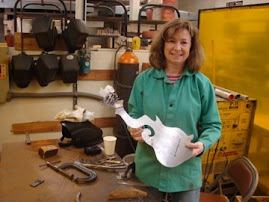The piece I have chosen for this blog is Nanni di Banco’s The Four Crowned Martyrs. Banco won the commission to create a sculpture representing the patron saints of the stone carvers and woodworkers guilds (to which he belonged) for the Guild Building, the Orsanmichele in Florence. His piece was completed between 1409-1417. Although Nanni chose to set the stage for his 4 Martyrs by placing them in what looks like a Gothic Church, with a roofline that became popular 100 years later in the Flamboyant Style as seen on the Church of Saint Maclou, he created his Martyrs in Classical Roman style. The four men have solid bodies, and are dressed in togas. But he does something different with them. He has them standing in a semi-circle that brings the viewer into the picture, as the completed imaginary circle extends outside of the niche to where the viewer would be standing. Below the 4 Martyrs, is a relief panel showing the sculptors at work. Although only a few inches deep, Nanni cut deeply into the panel to give his figures a 3d depth that is very effective.
The top photograph shows the stone carved niche as it would have been seen right up to as recently as 2005, when it was cleaned. Covered in the black grime of the modern city of Florence, many people probably just walked past and did not take in the beauty of this piece. The lower photo is the way it looks today, and the way it looked back in 1417 when it was completed. What a difference! The figures are very realistically carved and are prominently set off by the black and white faux dome just inside the niche.
I was drawn to this piece because I am just finishing up my first stone sculpture. My piece is 2 feet wide by 1 foot high by 2 feet deep, and weighs around 65 lbs. It has taken me weeks to carve and in the last week, I have spent hours polishing the surface. I can not imagine working on 4 human figures, each 6 feet high, and with that detail of their clothing and facial expression… and not break it at some point! How did Nanni even get his stone sculpture into that niche? It must have weighed thousands of pounds! I can hardly lift my small sculpture to get it on the worktable each day. I have a whole new respect for stone carvers of any time period!



